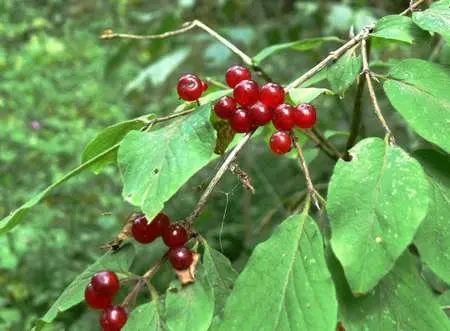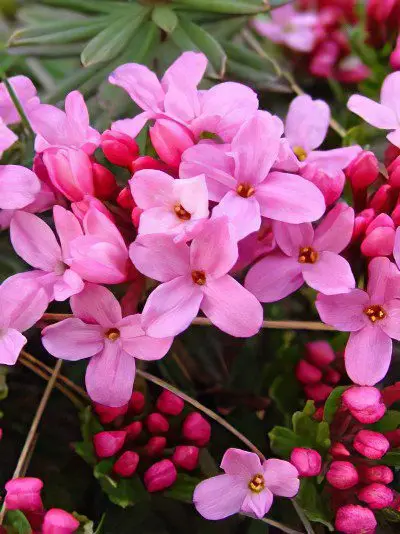Contents
Botanical characteristics of the wolfberry

Daphne – small evergreen or deciduous shrub with red berries. It blooms in late winter or early spring, bears fruit in July-August. Fragrant flowers consist of 4 or 5 petals, fused at the base into a tube. In evergreens, flowers with a greenish tint, in the falling wolfberry – pinkish. The plant is highly poisonous.
The wolfberry lives in the mountains of Europe, North America and Asia. In Russia, it can be found mainly in the Kursk and Belgorod regions. This shrub grows on gravel and limestone soils, chalk outcrops. The plant is protected by law and is listed in the Red Book of Russia.
Useful properties of the wolfberry
All parts of the wolfberry contain toxic substances – daphne glycoside and meserine resin. The composition of the flowers includes flavonoids, coumarins, benzoic acid and fats. The bark contains wax, dye and gum. Wolfberry preparations have effective antibacterial, laxative, hypnotic, antiepileptic and antitumor properties. They are used, as a rule, externally – in the form of a highly irritating agent.
For the preparation of preparations, the bark and fruits of the plant are used, sometimes branches with leaves. The bark is harvested before flowering, in early spring. It is cut into strips, laid out in a layer and dried under a canopy in the open air or in well-ventilated areas. The fruits are harvested in July-August, dried in special dryers at a low temperature. Even after drying, the plant does not lose its poisonous properties, so it is recommended to carry out all the harvesting work with gloves.
Wolfberry is one of the earliest and most generous honey plants. However, fresh honey is poisonous and can cause inflammation of the mouth and intestines. It can only be used after boiling.
The use of the wolfberry
In folk medicine, alcohol tincture from the wolfberry is used externally as an effective remedy for rheumatism, gout, sciatica, abscesses and tumors. Previously, the decoction was used for sore throats, colds, insomnia, jaundice, tuberculosis. Drugs based on the bark of the wolfberry are also considered effective. They are used for some skin diseases, inflammation of the eyes, aching joints. Fruit juice is recommended to lubricate the bites of snakes and dogs, flowers are used as a strong anthelmintic.
Decoction: in 250 ml of boiling water, pour 4 g of roots, heat the composition in a water bath for about 30–35 minutes, then let it brew for 15 minutes, filter and drink 2 times a day, 1 teaspoon before meals.
Tincture: 1 g of the fruit or bark of the plant must be poured with 100 ml of 70% alcohol, insisted for a week, shaking occasionally, and strained through gauze. In a tablespoon of water, you need to dilute 1-2 drops of tincture and take 3 times a day before meals.
Infusion: 1 g of crushed fruits should be poured with distilled water in a volume of 250 ml and infused for 10-12 hours. After diluting 5 drops of the medicine in a spoonful of water, it should be taken 3 times a day after meals.
What is dangerous wolfberry
The whole plant is poisonous, and very strongly. Flower pollen, when inhaled, causes irritation of the mucous membranes of the nose and respiratory tract. After eating the berries, there is a burning sensation in the mouth, pain in the stomach, nausea, vomiting, weakness, convulsions are possible. If the juice of the plant gets into the eyes, it threatens with difficult-to-heal ulcers of the cornea. When even a piece of bark gets into the mouth, burning and scratching is felt, blisters and ulcers form on the mucous membranes. From the touch of a wet bark to the skin, purulent wounds can form. The use of the wolfberry in medicine is dangerous and is always accompanied by a risk to human health.
Wolfberry ordinary (wolf bast)
This is a low, slightly branched shrub from 50 cm to 1 m in height; on favorable soils, the plant reaches 2,5 m. The trunk and branches are gray-brown in color. Reddish, pleasantly scented flowers bloom before the appearance of lanceolate leaves. Fruits are oval, light red. This species blooms in April-May. The plant prefers nutrient-rich soils, shady places, grows in forests, along the banks of streams. There is a wolf’s bast in the north of the European part of Russia, in Western Siberia, in the Caucasus.
Borovoy wolfberry

This species is an evergreen shrub with a height of 20 cm to 1 m. Its trunk and branches are densely covered with small leathery leaves, pinkish or cherry-colored flowers grow at the ends of the stems and are collected in inflorescences in the form of heads. The fruit is a yellow-red berry. Borovoy wolfberry blooms in the first half of May, secondary flowering is possible in July-August. The plant is found in Ukraine and Belarus. This species grows in small groups in a limited area, as well as in pine forests of medium humidity.
Due to its decorative and medicinal properties, the plant is destroyed by the local population. For example, in the Pripyatsky Reserve, this species of wolfberry is under protection. It is also listed in the Red Book of a number of European countries. In folk and official medicine, the plant is used to treat gastrointestinal diseases, cancer, neuralgia and paralysis. The decoction is used as a hypnotic and antiepileptic agent.
Contraindications to the use of wolfberry
All medicines containing the plant are poisonous. They can only be used after consultation and under the supervision of a doctor. Self-treatment with a wolfberry is comparable to suicide. The use of wolfberry preparations, even in the form of rubbing, is strictly contraindicated for pregnant and lactating women and children. Do not use drugs for any bleeding, with arrhythmia, heart failure, tachycardia. Be sure to observe the exact dosage of these drugs.









